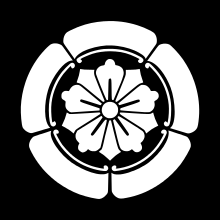Arima (Klan, Hizen)
The Arima ( Japanese 有 馬氏 , Arima-shi ) from the province of Hizen were a family of the Japanese sword nobility ( Buke ), which was derived from Fujiwara no Sumitomo († 941). With an income of 50,000 koku , the Arima residing in Maruoka ( Fukui Prefecture ) belonged to the smaller Tozama daimyo of the Edo period .
history
- Tsunezumi ( 経 澄 ), descendant of Sumitomo in the 8th generation, served the Shogun Sanetomo and built a castle in Arima and then took this name.
- Haruzumi ( 晴 澄 ), was the companion of Shōgun Ashikaga Yoshiharu on trips as Shōbanshū and ruled over six districts of Hizen. He was defeated by Ōtomo Yoshinori.
- Yoshisada ( 義 貞 ; 1521–1577), son of Haruzumi, made peace with the Ōtomo, then fought Ryūzōji Takanobu. He lost and had to make peace with him. Yoshisada was baptized as a Christian and was given the name Andrea.
-
Harunobu ( 晴 信 ; 1567–1612), second son of Yoshisada, took over the property after his brother's death. Together with the Shimazu clan, he was able to defeat Takanobu, who lost his life in the process. After successfully participating in a campaign in Kyushu, Toyotomi Hideyoshi confirmed him in his domains in Hizen, where he owned two castles, Hara (also called Arima) and Hi-no-ura (also called Hi-no-e) with an income from 40,000 koku .
In 1608 Harunobu sent a ship to Macau , which wintered there. It came to confrontations between the Japanese and the port people, which were ended by the Portuguese governor Andrea Pessoa with punishment of the Japanese. The following year Pessoa came to Nagasaki on the ship “Madre de Dios” and informed the shogunate of the reasons for his action, which were accepted. But Harunobu got Tokugawa Ieyasu to reverse his decision and order him to hijack the ship. It took Harunobu 1200 men and three days until Pessoa finally gave up and blew himself and his ship up.
Harunobu remained in trouble: he was reported to be a Christian (in fact, he was baptized Johann Protasius in 1579) and he was suspected of plotting to take possession of Isahaya (Hizen) Castle. Harunobu was exiled to Yamura ( Kai ) and eventually sentenced to death. - Naozumi ( 直 純 ; 1586–1641), Harunobu's son, had been baptized under the name Michael. But after marrying a great-granddaughter of Ieyasu, he became a severe persecutor of the Christians. Since his father had fallen out of favor, the family property was also lost in 1612. In 1615 he received the Nobeoka - han in the Hyūga province with 53,000 koku.
- Kiyozumi ( 清純 ; 1644–1703), Naozumi's grandson, lost his fiefdom ( han ) in 1691 due to poor administration , but was transferred to Maruoka- han with an income of 50,000 koku four years later .
The Arima resided in Maruoka until the Meiji Restoration . After that, the head of the house held the title Vice Count until 1945 .
Remarks
- ↑ mokkō , usually written 木瓜 - not to be confused with the same spelled but boke- read term for the Chinese ornamental quince - is a common symbol of Japanese coats of arms ( mon ) adopted from China .
- ↑ Shōbanshū ( 相伴 衆 ) was a title for high-ranking travel companions, which was first given to Hatakeyama Mitsuie by Shogun Ashikaga Yoshimitsu in 1421 . In addition to the Hatakeyama , the Shiba , Hosokawa and Daimyō families with a military reputation also belonged to them.
literature
- Papinot, Edmond: Historical and Geographical Dictionary of Japan. Reprinted by Tuttle, 1972 edition of 1910 edition. ISBN 0-8048-0996-8 .
